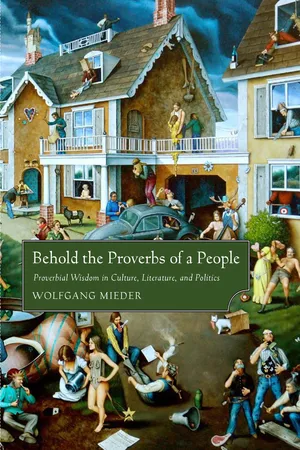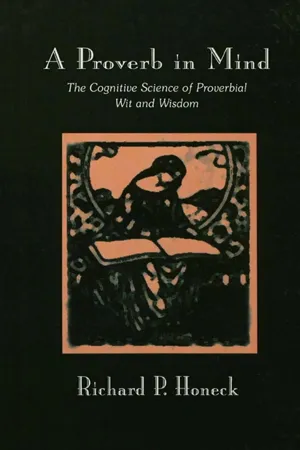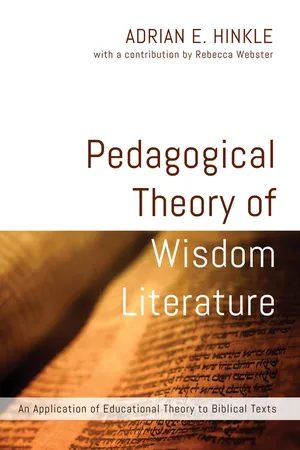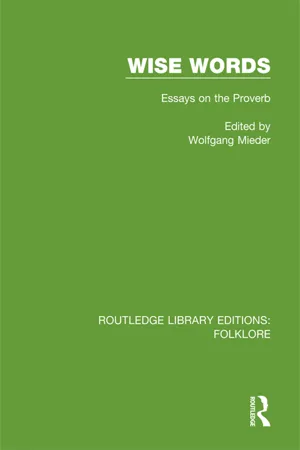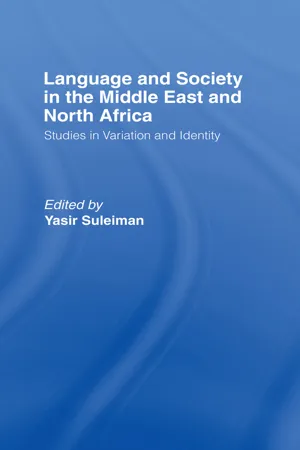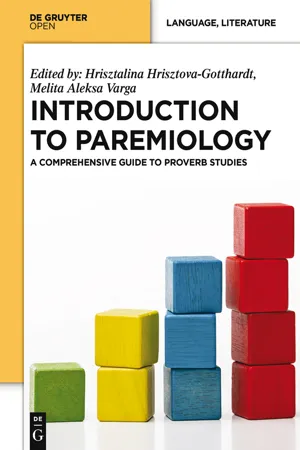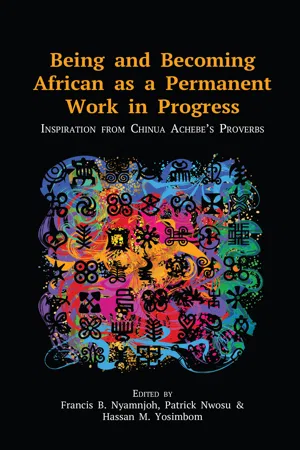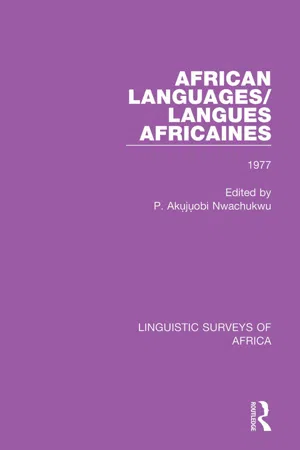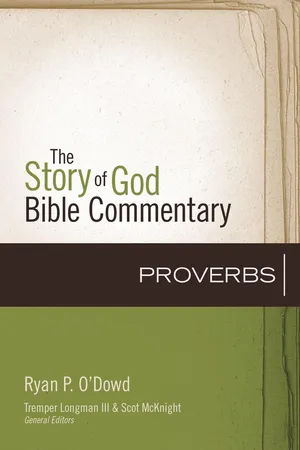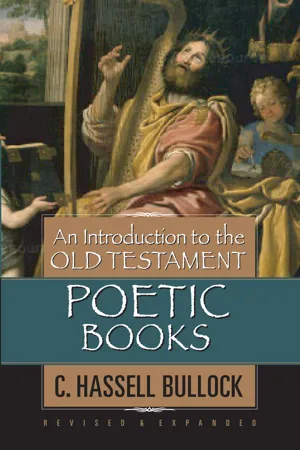Languages & Linguistics
Proverbs
Proverbs are short, pithy sayings that express a general truth or piece of advice. They are often used to convey cultural values and beliefs, and are passed down through generations. Proverbs can be found in many languages and are an important part of oral tradition.
Written by Perlego with AI-assistance
11 Key excerpts on "Proverbs"
- eBook - ePub
Behold the Proverbs of a People
Proverbial Wisdom in Culture, Literature, and Politics
- Wolfgang Mieder(Author)
- 2014(Publication Date)
- University Press of Mississippi(Publisher)
A frequency study of the words contained in the definition attempts made it possible to formulate the following general description: “A proverb is a short, generally known sentence of the folk which contains wisdom, truth, morals, and traditional views in a metaphorical, fixed and memorizable form and which is handed down from generation to generation” (Mieder 1985b: 119; also in Mieder 1993: 24). This summary definition mirrors that of Whiting, while the short conglomerate version “A proverb is a short sentence of wisdom” based on the words most often used in the fifty-odd definitions resembles Taylor’s statement. People in general, not bothered by academic concerns and intricacies, thus have a good idea of what a proverb encompasses. This is also borne out by a number of Proverbs about Proverbs, representing folk definitions as it were: “Proverbs are the children of experience,” “Proverbs are the wisdom of the streets,” and “Proverbs are true words.” Proverbs obviously contain a lot of common sense, experience, wisdom, and truth, and as such they represent ready-made traditional strategies in oral speech acts and writings from high literature to the mass media (Hasan-Rokem 1990). But proverb scholars have, of course, not been satisfied with the vagaries of this type of definition. Again and again they have tried to approximate the definition (Arora 1984). Suffice it to cite two more general work-definitions, starting with Stuart A. Gallacher’s short statement: “A proverb is a concise statement of an apparent truth which has [had, or will have] currency among the people” (1959: 47). The parenthetical modifications have been added by me to indicate that while some Proverbs have been in use for hundreds of years, others have passed out of circulation and new ones will certainly be coined. One of my own attempts of defining Proverbs precisely shows my indebtedness to my teacher Stuart A - eBook - ePub
A Proverb in Mind
The Cognitive Science of Proverbial Wit and Wisdom
- Richard P. Honeck(Author)
- 2013(Publication Date)
- Psychology Press(Publisher)
For Norrick (1994a), Proverbs are “doubly indirect” in that they act as quotes, a la Cram (1994), that come from the larger culture rather than the speaker, and their message is not isomorphic with their literal meaning. Norrick claimed that Proverbs are used to avoid double binds in interpersonal situations because the proverb allows the speaker “to disguise his true feelings, to leave himself an escape route, to offer his hearer choices and to indicate real or imagined consensus” (p. 148). Therefore, Proverbs are natural choices for the perlocutionary acts of instructing, consoling, warning, and the like. Norrick also argued that such effects are intentional and can have either short-term or long-term effects.In conclusion, although attempts to define the proverb have been interesting and highly informative, there is no generally agreed upon definition. A proverb can be regarded as A discourse deviant, relatively concrete, present (nonpast) tense statement that uses characteristic linguistic markers to arouse cognitive ideals that serve to categorize topics in order to make a pragmatic point about them. This mouthful will not completely satisfy all scholars including the author of this volume. The problem is that, like any good definition, it should flow from an adequate theory. Paremiology comes up a bit short on this score. Perhaps Archer Taylor (1931), one of the century’s premier proverb scholars, had this in mind when he penned the following (what could be called “Taylor’s Curse”):The definition of a proverb is too difficult to repay the undertaking; and should we fortunately combine in a single definition all the essential elements and give each the proper emphasis, we should not even then have a touchstone. An incommunicable quality tells us this sentence is proverbial and that one is not. Hence, no definition will enable us to identify positively a sentence as proverbial. Those who do not speak a language can never recognize all its Proverbs, and similarly much that is truly proverbial escapes us in Elizabethan and older English. Let us be content with recognizing that a proverb is a saying current among the folk. At least so much of a definition is indisputable, and we shall see and weigh the significance of other elements later, (p. 3) - eBook - ePub
Pedagogical Theory of Wisdom Literature
An Application of Educational Theory to Biblical Texts
- Hinkle(Author)
- 2017(Publication Date)
- Wipf and Stock(Publisher)
Chapter 5Pedagogy of Proverbs
S imilar to Job, Proverbs utilizes nature, religious tradition and parallels with the Pentateuch as pedagogical tools to reinforce religious ethos. As demonstrated in other biblical texts, the writers/editors of Proverbs include examples of active learning through visual and kinesthetic objects/events to enforce their theological perspective. As will be demonstrated, these examples will correspond to Flemings’ VARK learning theory as well as soundly constructed examples of social cognitive theory.Proverbs occupies a unique niche within the Hebrew Bible as it allows the readers to consider lessons learned by others within the social community. The recording of the proverb ensures the potent social factors are preserved for guidance in ambiguous situations.237 The proliferate literary use of Proverbs extends to extrabiblical literature and prevalently endorse culturally specific language and social values.238 Richard Honeck further addresses the role of Proverbs as he writes, “Proverbs also teach their hearers, children especially, a great deal about [language].”239 He goes on to state,[ . . . ] Proverbs provide implicit instruction in levels of meaning and cognitive flexibility. Language is ideally suited for these purposes. It can turn reality on it is head in a way that perception cannot. Perceptual illusions occur, but perceptual veridicality is the rule not the exception. When we perceive what seems like a tree, it usually does not turn out to be a dog. In contrast, language allows people to say one thing and mean another. Proverbs optimize this bifurcation. Yet, proverb comprehension also requires that what was said to be taken into account, using context and conversational rules of various kinds. Because Proverbs are used in indirect ways and can diffuse responsibility for the pragmatic and social message, the listener is taught that language is a tool. Thus, Proverbs may facilitate the development of crucial conversational skills. They may also teach metacomprehension skills that will allow the listener to detect and resolve discrepancies between their current understanding and a more appropriate understanding.240 - eBook - ePub
Wise Words (RLE Folklore)
Essays on the Proverb
- Wolfgang Mieder(Author)
- 2015(Publication Date)
- Routledge(Publisher)
The Linguistic Status of the ProverbDavid Cram*Linguists of various schools have investigated the language, grammar, structure, and form of Proverbs. There is now even a special field of phraseology that deals with all formulaic language, including Proverbs, quotations, idioms, twin formulas, etc. Lexicographers are also paying much closer attention to phraseological units, and the same is true for foreign language instructors. A few representative studies are Adam Makkai, Idiom Structure in English (The Hague: Mouton, 1972); Agnes Szemerkényi and Vilmos Voigt, “The Connection of Theme and Language in Proverb Transformations,” Acta Ethnographica Academiae Scientiarum Hungaricae, 21 (1972), 95–108; Aleksandr K. Zholkowskii, “At the Intersection of Linguistics, Paremiology and Poetics,” Poetics, 7 (1978), 390–332; Neal R. Norrick, How Proverbs Mean: Semantic Studies in English Proverbs (Amsterdam: Mouton, 1985); Terence Odlin, “Language Universals and Constraints on Proverbial Form,” Proverbium, 3 (1986), 125–151; and Dmitrij Dobrovols’kij, Phraseologie als Objekt der Universalienlinguistik (Leipzig: Verlag Enzyklopädie, 1988).In his clearly argued article David Cram states that the proverb should be viewed as a lexical element with a quotational status. The proverb is a lexical element in the sense that it is a syntactic string which is learned and reused as a single unit with a frozen internal and external structure. Its quotational status derives from the fact that Proverbs are typically “invoked” or “cited” rather than straightforwardly asserted. All of this is explained in the three major sections of this essay on (1) proverbial competence (the proverb as a lexical item), (2) proverbial performance (the proverb as a speech act), and (3) proverbial logic (proverb systems and proverbial thinking). - Yasir Suleiman(Author)
- 2013(Publication Date)
- Routledge(Publisher)
(The context of situation of course has since become a founding concept in Jakobson’s functional model, and I shall have more to say about it below.) With time on our hands and nothing else to do, our conversation was oriented to keeping alive the contact between us, but given the semantic import of Proverbs and their rhetorical power, what took place at that session was a far cry from phatic communion understood as a ritualized exchange of small talk (cf. Laver, 1975:233–236). In the research cited earlier (Muhawi 1996) it was noted how the members of one speech community (Tunisians) use a genre of Arabic verbal art, the ethnic joke, to create an identity boundary between themselves and those belonging to another speech community (Libyans), even though both groups are part of the larger community of Arabic speakers. Here the proverb will be seen as providing what we might call a linguistic and cultural identity-bridge between different groupings of the larger Arabic speech community, namely, Tunisians and Palestinians. Normally, Proverbs are used rhetorically to give advice, to comment on an event, or to encapsulate a story. Yet here was a situation that contravened the accepted norms of proverb use as well as received wisdom about what constitutes phatic communion. Rhetoric enters the scene both synchronically and diachronically; the former because Proverbs by definition are rhetorical structures, and the latter because the session itself, which started out as an innocent exchange of Proverbs with a phatic intent of passing the time amiably, took on the dynamics of a rhetorical genre as the element of performance entered the scene. What gradually emerged came close to what might be described as a verbal duel between the two members of the group who knew the greatest number of Proverbs, Rashad and Abdulhamid.Our intention in this research is therefore to use the proverb as a means of exploring the question of phatic communion from a sociolinguistic perspective that combines rhetorical and folkloristic considerations. This perspective, which puts the emphasis on the relation of the proverb to the speech community, is in harmony with the founding thought of de Saussure, who always insisted that language was a social bond (1966:13) that belongs to the collectivity and is not the property of an individual — “speech has both an individual and a social side, and we cannot conceive of one without the other” (p 8); and again, “for language is not complete in any speaker; it exists perfectly only within a collectivity” (p 14). The model of communication generally accepted in the discipline seems to us to be a projection into the sociolinguistic domain of the linear movement of syntax and sound in articulated speech. We find this outlook fully spelled out in Hockett’s recent work: “In speech you can only move in one direction: from earlier to later. The syntax of speech is not only unidimensional but also UNIDIRECTIONAL (emphasis original). When … we characterize speech as LINEAR (original emphasis), we shall mean just this combination, unidimensionality and unidirectionality” (1987:6). It may be argued that there is no necessary contradiction between de Saussure’s perspective and Hockett’s statement or Jakobson’s model, and as far as it goes this argument is valid. However, what is ignored is the discursive relationship between initial assumptions and final conclusions. If one starts out from the assumption that language is univocal and linear then the emphasis on the sender/addresser and receiver/addressee would naturally seem to follow. If on the other hand we start from the assumption of the collectivity of language, then the phatic aspect of speech, which highlights the intersubjective environment necessary for all communication, will receive a higher priority in any functional taxonomy of speech acts than either the sender/addresser or the receiver/addressee.- eBook - ePub
- Hrisztalina Hrisztova-Gotthardt, Melita Aleksa Varga, Hrisztalina Hrisztova-Gotthardt, Melita Aleksa Varga(Authors)
- 2015(Publication Date)
- De Gruyter Open Poland(Publisher)
Anna Lewandowska, Gerd Antos In cooperation with Dana Gläßer
7 Cognitive Apects of Proverbs81
7.1 Introduction
From the cognitive point of view Proverbs are linguistically and culturally coined frames. Especially in spoken language, these frames work well for knowledge transfer due to their conciseness. Usually, Proverbs are linguistically easy to identify based on their stereotyped character and consistence. Their economised form helps the speaker to remember and recognise them easily. Therefore, Proverbs can be referred to as verbal stereotypes of knowledge which allow their users to comment on, standardise and evaluate new situations with the help of known social clichés. Against this background, we pose the following questions: What makes Proverbs stereotyped? Which influence has the linguistic form of Proverbs on our ability to memorize and duplicate them? Which role do Proverbs play for social knowledge transfer? Henceforth, we will discuss the above questions under a cognitive point of view. We will concentrate on Lakoff and Johnson’s Conceptual Metaphor Theory as frame to create a cognitivist understanding of Proverbs (Lakoff & Johnson, 1992 ).7.2 Lakoff and Johnson’s Conceptual Metaphor Theory
The Conceptual Metaphor Theory by George Lakoff and philosopher Mark Johnson is based on the assumption that “metaphor is pervasive in everyday life, not just in language but in thought and action. Our ordinary conceptual system, in terms of which we both think and act, is fundamentally metaphorical in nature” (Lakoff & Johnson, 1992: 3 ).Around 1980, this thesis82 was revolutionary. It is premised on a then new cognitivist approach which has been defined more precisely through the central term metaphorical concept (MC):The concepts that govern our thought are not just matters of the intellect. They also govern our everyday functioning, down to the most mundane details. Our concepts structure what we perceive, how we get around in the world, and how we relate to other people. Our conceptual system thus plays a central role in defining our everyday realities. If we are right in suggesting that our conceptual system is largely metaphorical, then the way we think, what we experience, and what we do every day is very much a matter of metaphor (Lakoff & Johnson, 1992: 3 - eBook - ePub
Intercultural Discipleship (Encountering Mission)
Learning from Global Approaches to Spiritual Formation
- Moon, W. Jay, Moreau, A. Scott(Authors)
- 2017(Publication Date)
- Baker Academic(Publisher)
An indication of the high regard that some cultures have for Proverbs is the prevalence and regular usage of Proverbs in these cultures. Writing about the Igbo language, Maazi Chijioke Asogwa notes, “[I was] able collect up to two hundred Proverbs from a single person in one sitting. We have also been able to collect up to one thousand in several sittings from one person” (2002, 49). Similarly, many of the Builsa were able and willing to share many Proverbs with me. One night a group of youth shared seventy-three Proverbs with me in an hour and a half with no sign of letting up.Clearly, Proverbs have an emic value that those outside the culture do not always appreciate. Intercultural disciplers look for emic reasoning patterns to transform worldviews. When they overlook indigenous reasoning patterns, Christianity appears foreign and irrelevant, which leads to split-level Christianity.Once the Proverbs are valued and used to express Christianity, the heartfelt, intimate issues of culture can be exposed and transformed by the gospel. This leads to intercultural discipling that uses indigenous reasoning, as the following story demonstrates.“This proverb encourages me to do the right thing,” shares Kofi. “During difficult times, it has helped me many times. Our elders say, ‘Pukawgi a laa ka tuik po’ (A widow laughs at the spot where she pounds millet).”SIDEBAR 8.1 The Value of Proverbs Consider the following indigenous Proverbs, which highlight the emic value of Proverbs:- A conversation without Proverbs is like stew without salt. Oromo proverb.
- Proverbs are the palm oil with which words are eaten. Nigerian proverb (Achebe 1959, 7).
- Proverbs are the horses of speech; if communication is lost, we use Proverbs to find it. Yoruba proverb (Lindfors 1973).
- Why are Proverbs held in such high esteem in some cultures but not in others?
- Consider the above metaphors used to describe Proverbs. How are Proverbs like salt, palm oil, and horses? What is being expressed by these open-ended metaphors?
- eBook - ePub
Being and Becoming African as a Permanent Work in Progress
Inspiration from Chinua Achebe's Proverbs
- B. Nyamnjoh, U. Nwosu, B. Nyamnjoh, U. Nwosu, Hassan M. Yosimbom(Authors)
- 2021(Publication Date)
- Langaa RPCIG(Publisher)
Thus, the Akan and other African societies have their peculiar definitions and descriptions of Proverbs. The Akan, for instance, regard Proverbs as the “vehicle for communicating belief systems, values, prescribed and proscribed attitudes and behaviors of people”. 21 A vehicle, as we already know, is anything that is used to transport people, animals or goods from one place to another. Vehicles thus make transportation easy and effective and save time, thus by likening Proverbs to vehicles the Akan want to emphasise the undeniable fact that Proverbs are very relevant and effective means of verbal communication. A recurrent idea that emerges from our discussion so far is that Proverbs by their nature are not attributed to anyone – they emerge from culture and become a popular usage on the lips of people. It is this anonymous nature of Proverbs that differentiates them from other pithy expressions such as aphorisms and apothegms. For instance, Joseph Russo makes the following remark about Proverbs: As the common linguistic property of all speakers constituting any linguistic community, Proverbs have no known author. Thus, when any speaker, ancient or modern uses Proverbs, he or she is invoking the authority of cultural norms embodied in intended verbal formulas that were invented by no one but known by everyone. 22 The foregone remarks resonate with Akan traditional conceptions of Proverbs. The Akan regard Proverbs as the language of anonymous ancestors handed down to succeeding generations through oral tradition, music and symbols. This accounts for the reason why, before a proverb is uttered, an Akan-speaking person will first of all attribute it to the elders or ancestors. 23 Among the Akan, Proverbs constitute a huge repertoire of a wide range of accumulated wisdom and experiences of the past generations that reflect the philosophy and the mind of the Akan people - eBook - ePub
African Languages/Langues Africaines
Volume 3 1977
- P. Ak?j?obi Nwachukwu(Author)
- 2017(Publication Date)
- Routledge(Publisher)
1968:4). Use of Proverbs The use of Proverbs will be shown in social interactions. Proverbs will be examined as independent products from their users (in the sense defined by Arewa and Dundes). In fact, Proverbs are generally used as indirect speech, for they are considered as part of the social heritage by a specific speech community. With the idea in mind that communication involves a ‘transaction between speaker and listener, both in the active process of give and take,’ the one who initiates the use of a proverb is more likely to avoid the responsibility of the effect that might be caused by the meaning of such a proverb. 10 Bascom states that among the Chaga of East Africa: ‘Proverbs are used to express a threat which the speaker may not later wish to carry out, to direct another’s action where a blunt command might offend, or to incite a person to action through irony’ (1965:293). From this description, it appears that the user of a proverb can to some extent be considered as an instrument through which the proverb is applied. He acquires anonymity from the fact that the proverb does not belong to him. On the contrary, it is like some kind of a ‘law’ known and recognized intuitively as such by other members of the group involved. ln fact, it is what Goffman (1961:105-15) shows as a way of ‘establishing role distance.’ Role distance is introduced ‘to refer to actions which effectively convey some disdainful detachment of the performer from a role he is performing.’ Thus as indicated above in the use of Proverbs, ‘the individual tries to isolate himself as much as possible from the contamination of the situation.’ This is because Proverbs stand as separate psychological realities and distant units that can be used to express feelings, ideas and opinions within a discourse under the cloak of anonymity - eBook - ePub
- Ryan O'Dowd, Tremper Longman III, Scot McKnight(Authors)
- 2017(Publication Date)
- Zondervan Academic(Publisher)
35 Books like Proverbs are evidence that, within every culture, some people recognize the value of these sacred traditions and seek to capture and preserve them for future generations. Where the sayings originated and how this process of collection took place are still almost entirely a mystery to us.Ancient Near Eastern Background
Despite the fact that we cannot tie down a specific date and occasion for Proverbs, we can still learn a great deal from Israel’s neighbors in Mesopotamia and Egypt.36 Both of these cultures produced a variety of wisdom texts that share many parallels with Job, Proverbs, and Ecclesiastes.The most consistent parallel with Proverbs is the setting of these sayings in a father’s writing to a son. Such preparation for adulthood is common in every human culture. Anthropologists call this a liminal stage, paralleling other major thresholds in human life—birth, adulthood, marriage, parenting, and death. Proverbs’ liminal material is most prominent in chapters 1–9 where the young man is repeatedly presented with the choice of two paths, two women, and their two houses. See the commentary in 1:1–7.Like Proverbs, other ancient wisdom literature works within a paradigm where God, king, humans, and creation exist in a common nexus. With God or the gods as creator in the heavens, the king represents the divine presence on earth and, as such, is the mediator of wisdom for the rest of humanity. Without the burdens of modern secular/sacred dualisms, ancient political life, ethical life, and religious life were thus seen to be part of the fabric of the created order. - C. Hassell Bullock(Author)
- 2007(Publication Date)
- Moody Publishers(Publisher)
13 His examples, however, could just as easily be used to illustrate the other direction of movement, from law to Proverbs. And in view of Proverbs as a teaching instrument, it would seem only logical that legal principles and injunctions were couched in proverbial form to make them more verbally memorable. The taking of bribes and the use of false weights are subjects of legal Proverbs:Deuteronomy 19:14 forbids one to remove his neighbor’s landmark. A parallel is found in Proverbs 22:28:D iverse weights and diverse measures,are both alike an abomination to the Lord.(20:10 RSV; cf. Deut. 25:13–16)Rephrasing laws in proverbial form was like the reweaving of an old fabric.D o not move the ancient boundaryWhich your fathers have set.The third subfunction is that of ethical instruction. As in the Egyptian and Mesopotamian instructions, the sages addressed their students as “my son.” The topics of the book of Proverbs, while appropriate to the broad spectrum of age, are clearly directed to the young whose surging emotions and untried idealism needed to be tempered by experience. Their lives could still be shaped in the ways of wisdom. The products of both theory and experience are offered in short, pithy sayings that might be used as a rule of thumb for personal conduct. R. B. Y. Scott has identified seven proverbial patterns according to which these principles for living are expressed:
Index pages curate the most relevant extracts from our library of academic textbooks. They’ve been created using an in-house natural language model (NLM), each adding context and meaning to key research topics.
Explore more topic indexes
Explore more topic indexes
1 of 6
Explore more topic indexes
1 of 4
